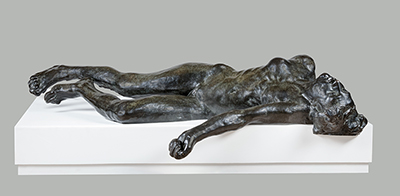The Martyr was sculpted by Auguste Rodin in 1885. Rodin was a French sculpture world renowned for larger than life works such as The Thinker, The Kiss and The Gates of Hell.
Although he experimented with everything from historic busts to anatomical studies, he had an exceptional skill in modelling intricate, gusty, deeply pocketed surfaces in clay. Traditional figurative sculptures at the time were formulaic, decorative and highly thematic. Rodin’s sculptures were often criticised as they went against these prime traditions. He was often inspired by themes of allegory and mythology, and as time grew on, he was increasingly influenced by literary works such as Dante’s inferno and Baudelaire’s The Flowers of Evil. Modelling the human form with realism, and great physicality and unique character, he is perhaps the most well-known sculptures outside the visual arts community.
The figure originally appeared on the tympanum and the bottom left-hand door of The Gates of Hell, symbolising fortune the figure was somewhat draped, with disguised eyes. While, keeping its shaping it had possessed on the door, it was then removed and enlarged to become an independent sculpture. The Martyr's emotion is uncertain, it can be interpreted as either expressive of misery or ecstasy. Her arms are wide apart, and her head is falling backwards in fitting with a traditional pose for those who had died a violent death. Rodin inspiration for the piece most likely came from Stefano Maderno's popular statue of Saint Cecila in Rome, 1600. However, there are also similarities with Bernini's Ludovica Albertoni in the Altieri Chapel in the Church of San Francesco finished in 1674.
The figure is unidentified and despite the traditional death positioning, there is no sign of a wound or violent death. The facial expression displays abandonment with closed eyes comparable to Bernini’s Ecstasy of Saint Teresa. It is open to the viewer’s interpretation whether the woman is in fact in great suffering or great pain. The Martyr is a bronze sculpture measuring 42cm high, with a width of 152cm, and a diameter of 100.5cm. Although originally at the Exposition Universelle as a show piece for the Bronze Age, it is now in the Musee Rodin in Paris.




